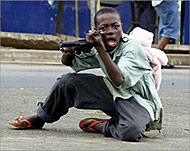Life and times of Charles Taylor
The Liberian president’s promise to step down on Monday is the latest development in a dramatic history which includes war crimes, diamond deals and gun-running.

Charles McArthur Ghankay Taylor became president of Liberia in July of 1997, taking over three quarters of the vote in an election international observers adjudicated to be fair.
The election of his fellow National Patriotic Party candidates to a majority of legislative seats in the National Assembly marked what many hoped would be the end of seven years of civil war.
Childhood
Born on 28 January, 1948 in Arthington, near Liberia’s capital of Monrovia, Taylor was one of seven children.
His father, Nelson, worked as a teacher, lawyer, and judge and was an Americo-Liberian, a group of descendents from Liberia’s original nineteenth-century settlers. His mother, Zoe, was a native Gola tribeswoman.
Studies in Monrovia did not go well, he was expelled from his secondary school for unruly behaviour. But as he grew older, he was drawn to the history of Liberia and its connections to the United States.
In 1972, the 24-year-old Taylor arrived in Boston through a student visa to study.
Student days
Working as a security guard, truck driver, and mechanic while attending Chamberlayne Junior College in Newton, Massachusetts, Taylor later transferred to Bentley College in Massachusetts, graduating with a BA in economics in 1977.
During his undergraduate years, Taylor joined the Union of Liberian Associations (ULA). He rose through the ranks of the organisation to become its national chairman.
 |
|
Taylor indicted for war |
Liberian President William Tolbert visited the United States in 1979 and met with Taylor, after the later led a demonstration outside the Liberian mission in New York City to protest Tolbert’s policies. Clearly impressed by the young man, Tolbert invited Taylor to return to Liberia.
Taylor did return at the beginning 1980, on the eve of a change that would alter both his fortunes and Liberia for good.
First coup
From its founding in 1847, Americo-Liberians had dominated the nation’s political life. The economic and social disparity between the ancestors of American slaves and the native people created feelings of resentment.
It was this resentment that helped spark a bloody coup that ultimately brought Taylor to power.
On 12 April, Tolbert was murdered by army sergeant Samuel Doe. Through a personal declaration, Doe became the first indigenous president of Liberia. Months of bloody retribution by native Liberians against Americo-Liberians ensued.
Despite his connection to Tolbert, Taylor’s economics background earned him a key position within the Doe government. As head of the General Services Agency, Taylor directed the purchasing of the Liberian government.
He was later removed from the post in May 1983, accused of embezzling more than $900,000 in government funds to a Citibank account. In October, Taylor fled to the United States.
Detention
Arrested in May 1984, a court in Boston determined that there were sufficient grounds to detain him while Liberia’s request to send him back were considered. In September of 1985, while awaiting extradition, Taylor escaped from the Plymouth House of Corrections.
The fugitive’s movements are not known over the next four years. Liberian and American authorities suggest he may have been in Libya, where it is believed he may have received shelter and military training from Muammar al-Qaddafi.
 |
|
Taylor’s use of children as |
Taylor returned to Liberia on Christmas Eve in 1989, at the head of a guerilla force of a few hundred men called the National Patriotic Front of Liberia [NPFL]. The NPFL settled in Gbarnga, some 100 miles northeast of Monrovia.
Taylor said he had returned to remove the government, declaring, “The best Doe is a dead Doe.” During the next seven months, Taylor’s forces gained ground and recruits, battling back an increasingly weakened government.
Conquest
NPFL forces entered Monrovia in July 1990. During the battle for Monrovia, the NPFL split into two factions, one led by Taylor and the other by Prince Johnson.
By September, both divisions of the NPFL declared victory over Doe’s government, but the Johnson-led group had secured and occupied the city of Monrovia.
Doe was captured and executed by Johnson forces as he attempted to leave the country.
A civil war between Taylor and Johnson forces ensued. In 1995, a peace agreement was signed, eventually leading to the election of Taylor as president in July 1997. Taylor took 75.3 percent of the vote, while his nearest competitor, Ellen Johnson of the Unity Party, received just 9.6 percent.
During his presidency, Taylor continued to battle those who opposed his rule. He also allegedly began selling arms and other supplies to rebels in neighbouring Sierra Leone, trading the weapons for diamonds.
The rebels Taylor aided continued their war against the Sierra Leone government, conducting brutal sweeps through civilian areas, chopping off the arms, legs and noses of thousands of suspected government supporters, including women and children.
On 4 June 2003, Taylor was indicted for war crimes by a United Nation’s tribunal in Sierra Leone.
Faced with growing international pressure to resign, Taylor has said he will leave on Monday, accepting an offer from Nigerian President Olusegun Obasanjo for temporary asylum.